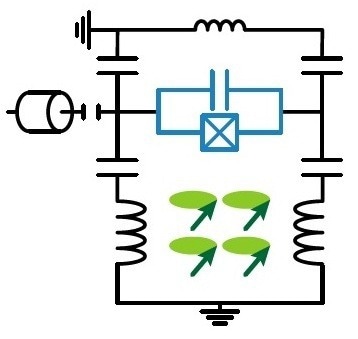In the journal Physical Review Applied, researchers from the University of Illinois Urbana-Champaign's Grainger College of Engineering have reported that coupling ferromagnetic materials to a superconducting qubit through a microwave cavity allows for an accurate description of highly excited magnon behavior in these materials.

Illustration of Magnon device flow. Image Credit: Pfaff/Roni Illustration
Quantum computing devices could be enhanced by devices that utilize the collective quantum behavior of spin excitations in magnetic materials, or “magnons.” However, a thorough comprehension of the nature and constraints of magnons is necessary for their use in quantum devices. Superconducting qubits are being used in a novel experimental approach to precisely characterize magnon behavior in previously unexplored regimes.
With the help of this configuration, the researchers were able to describe the quantity of magnons and their lives in the understudied regime of thousands of excitations.
To be useful in quantum computing applications, limitations on magnon systems need to be understood properly. The problem is that there isn’t a good theory for when certain effects become important, and if we should expect them to lead to detrimental effects. Our experiment shows that we can use superconducting qubits as flexible detectors to study magnons in these magnetic systems over a large range, which is exciting both for the quantum computing connection and for fundamental science.
Sonia Rani, Study Lead Author, University of Illinois Urbana-Champaign
Magnon devices can improve quantum computers by providing features such as nonreciprocity, which allows information to travel exclusively in one direction, and transduction, which converts between different operating frequencies for different systems.
These features assume linear magnon behavior, which means that the magnon excitations in the material do not interact with one another and that their damping can be characterized using basic, empirical models. It is unclear where these assumptions break down and whether this is relevant for quantum device applications.
To investigate systems with a large number of magnons present, Rani and her colleagues used a device known as a superconducting qubit, a quantum computing component whose sensitivity to electric fields makes it useful for precision measurement.
They connected it to the magnon gadget, which is sensitive to magnetic fields, via a microwave cavity, where electromagnetic waves facilitate the conversion of electric and magnetic forces.
Through the experiment, the scientists were able to investigate the behavior of the magnon using two different methods. The first, dispersive frequency shift, exploits a correlation between the frequency of operation of the superconducting qubit and the quantity of magnons present.
Due to this, the researchers were able to determine the exact number of magnons present with a 0.5% inaccuracy. The second method, parametric pumping, can be used to regulate the strength of a transient interaction between the qubit and the magnons. This made it possible to track the decay of the magnon excitations and gave another way to measure the number of magnons present.
“Parametric pumping is particularly appealing because it allows us to accurately explore the magnon dynamics as the system evolves in time, and it does it in a way that does not degrade the superconducting qubit sensor. It’s a flexible, integrated approach ideal for monitoring magnon dynamics,” added Rani.
The material investigated by the researchers in this work, yttrium-iron-garnet, had linear behavior with well-understood damping properties up to 2,000 magnon excitations. Future research could look into more magnetic materials with stronger excitations to better understand the start and impact of nonlinear processes, such as magnon interactions.
This work sets the stage for new kinds of quantum devices in two ways. First, it shows in a very practical way how we can integrate superconducting qubits and magnetic systems – two platforms that are normally very much at odds with each other. And second, it allows us to `screen’ magnetic systems for nonidealities that would compromise the performance of a quantum device.
Wolfgang Pfaff, Professor, University of Illinois Urbana-Champaign
The National Science Foundation and the US Department of Energy both supplied funding.
Journal Reference:
Rani, S., et al. (2025) High-dynamic-range quantum sensing of magnons and their dynamics using a superconducting qubit. Physical Review Applied. doi.org/10.1103/6dmm-mnxd.